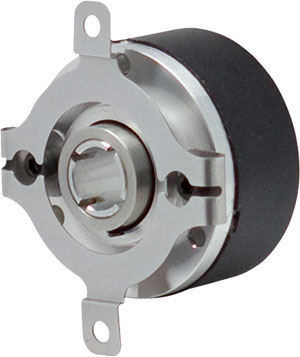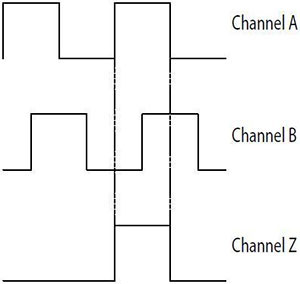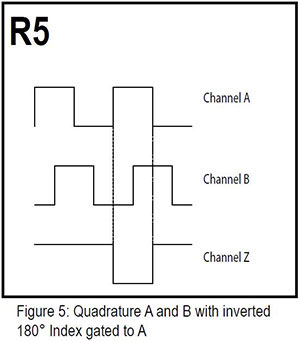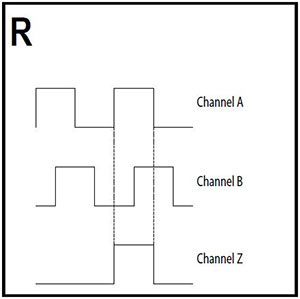6 Rotary Encoder Specification Tips
 Servo motors require accurate rotary encoder feedback for proper function. Install the wrong encoder and you could end up with an expensive door stop. Here are a few tips to help ensure successful specification of EPC's Accu-Coder Model 15T/H - both for new servo applications or for cross-reference replacement.
Servo motors require accurate rotary encoder feedback for proper function. Install the wrong encoder and you could end up with an expensive door stop. Here are a few tips to help ensure successful specification of EPC's Accu-Coder Model 15T/H - both for new servo applications or for cross-reference replacement.
6 Rotary Encoder Specification Tips

Industrial-duty servo motor applications are a tall order for any incremental rotary encoder. Enclosed in a cover with sustained temperatures reaching 120C, the encoder operates in what is essentially a compact thermal cycle test oven! EPC's Model 15T/H Accu-Coder ("T" = through-bore, "H" = blind hollow bore) was engineered from the beginning for just such a task and is frequently selected by OEM's and aftermarket service and repair operations for servo motor applications.
If you are specifying a Model 15T/H for servo motor application, you will of course pay attention to the basics: disk resolution (CPR), output type, voltage, mounting hardware, etc. Here are a few points for additional consideration:
1. Commutation: Installing and aligning an encoder with commutation channels can be a tricky task. In fact, if you are not familiar with how to do this, we strongly recommend using the services of a Servo Repair specialist. If you need assistance locating one in your area, please contact us. Over the years we have worked with dozens, coast-to-coast, and can likely provide a referral in your region. (We have also dealt with customers who have encountered challenges trying to "DIY" the alignment without proper equipment and know-how.)
2. Quadrature Phasing: Any time you are replacing an encoder, matching the output wave-form is critical. Ideally, you'll have the manufacturer's technical data sheet available for reference. Be sure you can determine the phase relationship between the A, B and Z (Index) channels.

This is usually defined in terms of whether the A channel leads the B channel, or visa versa, when the shaft rotates. Be sure to confirm the shaft view reference point - from the front or back of the encoder? Also check whether or not the shaft rotation direction is Clockwise or counter-clockwise.
EPC's standard quadrature phasing is: A channel leading B channel, with clockwise shaft rotation, viewed from the mounting face. We also offer a number of quadrature phasing options for the Model 15T/H.
3. Index Pulse Polarity, Width and Gating: The Index or Reference Pulse (usually designated Z channel) is a single pulse that occurs once per revolution. If your encoder has a reference pulse, there are several points to confirm prior to specifying a replacement encoder. Refer to the Waveform Diagram to determine these features.
Pulse Polarity: Some manufacturers use an Inverted Index with negative pulse polarity. The pulse is negative in its active state, as illustrated with this waveform diagram (compare to the diagram above). Specifying a positive index when a negative is needed, or visa versa will lead to an index pulse that does not get read by the controller:

Pulse Width is usually described in electrical degrees. Most encoder manufacturers use 180 degrees or 90 degrees. However, some older-technology encoders have an index pulse with an unspecified width. Providing the correct pulse width is important due to the fact that the servo motor controller may not be able to detect the index pulse if it is too short in duration.
Pulse Gating refers to the timing of the index pulse in reference to the A and B channels. There are numerous possibilities, including an Ungated Index, which is common on many imported encoders and a number of older-technology domestic encoders. An Ungated Index pulse will not always be the same width, but is usually centered in relation to one of the A or B channels. EPC offers a number of Index channel options for the Model 15T/H.
EPC's Standard Index Gating is a 180 deg positive index pulse, gated to Channel A. This is designated "R" in EPC's part number system.

4. High Temperature: Heat is an enemy for most electro-mechanical devices - including encoders. We strongly recommend selecting the high-temperature option for any Model 15T/H being applied for servo motor duty. With an operating temperature rating of -20C to 120C, your encoder will attain the longest service life possible. When EPC manufactures an encoder with high-temp rating, we use special adhesives and components selected for high-temperature durability. We also conduct a high-temperature test procedure that verifies your encoder operates within specifications at sustained 120C temperatures. In addition to adversely impacting electrical components, high temperature also break down bearing lubricants, leading to premature bearing wear and failure. To offset this risk we also use a special high-temperature bearing grease.
5. Connector: Typically, servo motor encoders are afforded little room to accommodate much in the way of a body-mounted connector. Generally a cable-end connector is used. Some motor manufacturers prefer flat cable in order to navigate a tight radius inside the encoder cover. Motor manufacturers use a number of custom connectors, so if replacing a servo motor encoder, be sure to take note of the connector and cabling requirements. In some cases, the existing connector can be salvaged, but it's best to use a new connector when possible. The Model 15T/H offers several choices: Cable, Cable with 5-pin or 8-pin in-line M12 connector and a new 15-pin header connector.
A 15-pin header is frequently employed by some motor OEM's for reasons particular to their manufacturing requirements. However, several benefits are also to be gained by machine OEM's and End-users alike for both new applications and aftermarket replacement.
The pin-header enables easy integration of specialized or custom cables and connectors supplied by third-party vendors. Also, when the 15T/H is used to replace other brands, it facilitates backward compatibility with existing connectors.
The Model 15T/H pin header is a available with Line-Driver output, 5VDC supply voltage and standard Quadrature Phasing. Due to the connector, IP50 is specified. See the Data Sheet for pin-out and more product details. The pin header is supplied with a mating connector and 18 inches of cable.
In many instances, the pin-header allows you to simply disconnect the existing cable from the encoder to be replaced and leave the cable intact. For applications in servo, stepper and PMDC motors, this greatly simplifies replacement.
RENCO Option: For certain RENCO encoders, EPC offers a cable with a special mating connector under the part number extension "SPEC779".
6. A Note About Footnotes: The Model 15T/H Data Sheet (and in fact, every EPC Data Sheet) includes footnotes that indicate certain configuration constraints or considerations. For example, the High Temp option (-20C to 120C) is available only with the 5VDC power supply. Fortunately, our internal product configurator will intercept part numbers with incompatible features at the time of order entry. However, that is usually inconvenient timing for all parties involved. If in doubt, you are always welcome to have the EPC Sales Team double-check your part number prior to ordering.
For the most part, specifying encoders for servo motor application is similar to any other specification process: understand the electrical, mechanical and environmental requirements of the encoder. A little extra attention to the points above could save some time, money and aspirin.

